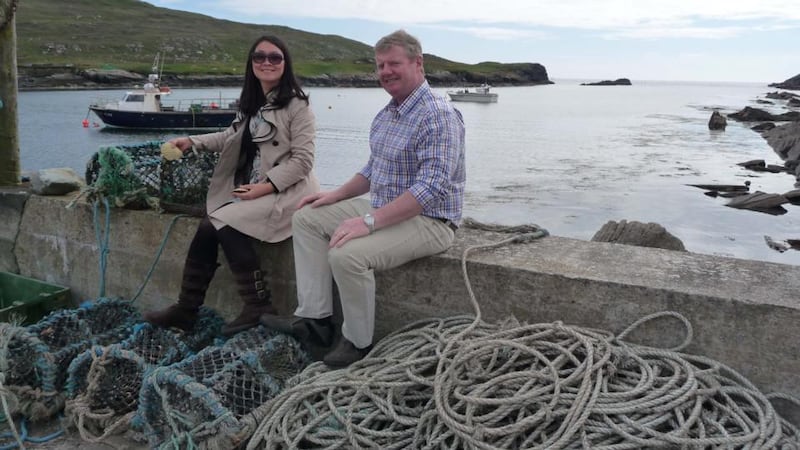The State’s exporters dispatched goods to more than 210 countries and territories last year. Products ranging from pharmaceuticals and livestock to sock garters and armoured fighting vehicles were among the goods that left Ireland to be sold in markets large and small around the world.
External trade data from the Central Statistics Office shows that, despite a €3 billion fall off between 2011 and last year, the US remained Ireland's largest export market by some distance, with more than€18 billion worth of goods shipped there last year.
In contrast, the State imported €6.4 billion worth of goods from the US in the same period, generating a balance of trade of some €11.7 billion.

Organic chemicals (€6.9 billion) and medical and pharmaceutical products, although down to €3.9 billion from €7.2 billion a year earlier, accounted for almost two-thirds of total trade between Ireland and the US.
Contact lenses
Manufactured articles – including products such as contact lenses and clothing – and machinery and transport equipment made up much of the remainder.
Britain (€13.8 billion), Belgium (€13.5 billion), Germany (€7.5 billion) and Switzerland (€5 billion) rounded of the State’s top five export markets, with pharmaceuticals and chemicals again the most traded products.
On the other hand, less well-known marketplaces such as the Falklands Islands (€1,000), Sao Tome and Principe (€2,000), the Turks and Caicos Islands (€2,000), Vanuatu (€2,000) and British Indian Ocean Territory (€2,000) were among the State’s smallest export destinations.
Transport equipment
Vanuatu, 1,750km east of Australia in the South Pacific Ocean, and Sao Tome and Principe, an island in the Gulf of Guinea off the west African coast, both imported machinery and transport equipment from Ireland.
Trade with the Falklands, the Turks and Caicos Islands and British Indian Ocean Territory was exclusively in manufactured goods.
Exports from Ireland to the emerging BRIC (Brazil, Russia, India and China) economies amounted to some €2.6 billion last year, and grew in three of the four markets.
Trade to China rose by 4 per cent to €1.56 billion (including €38 million worth of animal hides, skins and furs), while exports to Russia surged by 18 per cent to €602 million (among it some €69.9 million of scrap metal and metalliferous ores).
Exports to India
Exports to India rose by 15 per cent to €235 million (with office machinery accounting for more than 20 per cent of the figure).
Medical and pharmaceutical products accounted for 41 per cent of total exports to Brazil, which fell by 10 per cent to €255.8 million.
Nigeria was the State’s largest African market with exports rising by 5 per cent to €304.7 million in 2012. Sales of fish, crustaceans and molluscs accounted for €66.8 million of this figure.
Nigeria also bought €99.2 million worth of essential oils, perfume materials and cleansing preparations from Irish-based firms.
Exports to Australia amounted to €724.1 million in the period, with more than a third of the figure again related to exports of medical and pharmaceutical products.
The figures show the large Irish emigrant population in Australia may well have been seeking a taste of home, with Irish beverage imports at €15 million, tobacco imports at €18 million and live animal imports at €43 million.
Live animals
Food and live animals accounted for almost a tenth (€8 billion) of Irish exports last year with some of our nearest neighbours in Britain (€3.2 billion), France (€592 million) and Northern Ireland (€503 million) the largest buyers.
Meats (€1.3 billion) and livestock (€139 million) accounted for the bulk of Irish food exports to Britain. Northern Ireland bought in almost €153 million of meats and €124 million of dairy products and eggs, while France took €334 million worth of meat and €122 million of fish and related products.
Further afield, Saint Helena, a remote island in the South Atlantic Ocean with a population of less than 5,000, imported some €130,000 of Irish goods last year, more than half of which was meat.
The figures show there were no exports to North Korea last year, as was the case in 2011, but that imports of North Korean goods almost doubled year on year to €1.9 million. Sound and telecommunications equipment accounted for €1.4 million of that figure.
14,000km from Ireland
Exports to French Polynesia, located in the South Pacific Ocean some 14,000km from Ireland as the crow flies, amounted to more than €1 million last year.
Office and data processing machinery (€598,000) was the main export to French Polynesia along with essential oils, perfumes and other toiletries (€142,000) and chemicals (€103,000).
On deeper inspection, the figures show that exports of girdles, corsets, braces, suspenders and garters decreased by some €2 million to €7.4 million, while imports of these goods increased by about €1 million to €12.7 million.
Under the heading arms and munitions, the data shows that €74,000 worth of tanks and other armoured fighting vehicles were exported last year, down from €290,000 a year earlier.
Exports of firearms amounted to €584,000 (up from €334,000 in 2011) and sales of "munitions of war and parts thereof" increased from €45,000 to €57,000 last year.
Case study: finding clients abroad in the oil and gas sector
With a core business focused on the offshore oil and gas industries, Cork-based Seftec has had to spread its wings in order to find clients.
The company, which produces machines used to simulate the crash landing of helicopters on to water or how to handle a fire on an oil rig, lists Azerbaijan, Malaysia, Mexico and Angola among the markets it has sold equipment into.
“We export equipment, primarily helicopter mock-ups and the fire -raining rigs, and we also export expertise in terms of training the trainers and the maintenance of the equipment,” says Seftec director Darren O’Sullivan.
Distribution, he says, is a challenge given the size of the equipment. Simulators recently shipped to Angola and Scotland required six and five containers respectively to transport them.
“We don’t have any one particular market so we do two things,” O’Sullivan explains.
“In some cases we put the shipping as part of the client scope, and for many of them shipping is their bread and butter. Other times we use local agents or shipping companies in Cork and figure it as we go.
“With various kinds of equipment and with different types of clients in different jurisdictions, no two jobs are the same. Each job is treated on its own merits and we have to be extremely flexible and adaptable.”
Servicing and upgrading the equipment after it is sold gives Seftec employees a chance to see the world, with O’Sullivan saying staff were currently retrofitting in Norway and Qatar and working on a new commission in Abu Dhabi.
“Business is steady for us,” he says. “We find that if the Gulf of Mexico slows down, southeast Asia picks up.
We are one of only a few companies doing this in the world, so we find our risk is well spread,” says O’Sullivan.
Case study: four Irish seafood firms take on China
There's strength in numbers, and a joint venture between four Irish seafood firms has afforded them an opportunity to try to tackle China head on.
OceanJade Seafood – which involves Donegal firm McBride Fishing, Cork companies Carr Shellfish and Shellfish De La Mer, and the Wexford -based Sofrimar – has seen the four pool resources and draw up a medium-term plan to gain a foothold in one of the world’s fastest growing markets.
The companies have in the last year established an office for their brand in Shanghai and have a Chinese director, Yan Zhao, working on market research, developing contacts and meeting distributors to discussing selling on products such as brown crab, mussels, prawns, scallops and smoked salmon.
“I’m long enough in the tooth to know this is a slow burner, we’re looking at three to five years,” says Peter O’Sullivan Greene of Shellfish De La Mer. “We have established the OceanJade brand to target China and we now want to develop it and for it to become recognisable.”
O’Sullivan Greene says that, while the market is a long way away, the logistics are well established with products sent by air freight costing about €2 per kg and sea freight costing 20 cent per kg.
Brown crab, one of the primary products OceanJade is pushing in the service and retail markets in China, can be dispatched in live, processed or frozen form, he says.
“It’s about having the right product that is suitable for the consumer in terms of quality and price,” O’Sullivan Greene says.
“We have to promote it as a lot of the products are new to China. Some people are willing to try it, some are not and we have built that factor into our plan for the next three to five years.”










